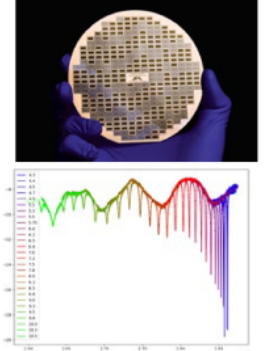
Daniel Cunnane
Microdevices Engineer
Education
- Ph.D. (2013) • Applied Physics • Temple University
- B. Sc. (2007) • Mathematics, Physics • University of Pittsburgh
Current Position
- Microdevices Engineer, NASA Jet Propulsion Laboratory, California Institute of Technology
- Research revolves around a wide range of both coherent and direct detection devices for remote sensing in the far-IR, specializing in applying novel superconducting materials for detector applications.

Figure 1 (Top) Array of superconducting MgB2 Test devices fabricated on a 4” Sapphire substrate demonstrating the first wafer scale MgB2 device capability.
(Bottom) Superconducting MgB2 Microwave resonator transmission for many different temperatures. Quality factors exceed 104 and have kinetic inductance of ~25 pH/sq at 4K. This is a demonstration of improvements that can be achieved through wafer scale processing.
Technology Interests
- Superconducting Non-Linear devices from bolometric, Josephson, and kinetic inductance effects.
- Using the Superconducting kinetic inductance effect at higher frequencies.
- Sub-mm detectors and receiver systems over a wide range of spectral resolution (from photometers to coherent receivers)
- Cryogenic Instrumentation for Space Telescopes
Goals and Aspirations
- Improving the technology portfolio in sub-mm astronomy to enhance or enable future science instruments.
- Advancing the TRL of novel material systems for integration with a space instrument.
- Advance superconducting technologies into THz frequencies through novel materials.
- By example, promote the development of creative and/or destructive technological solutions to both NASA and non-NASA problems through out-of-the-box thinking.
























